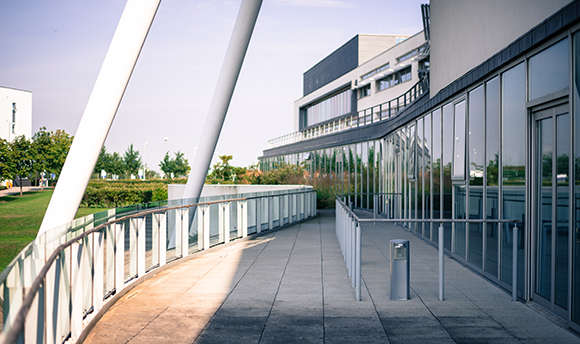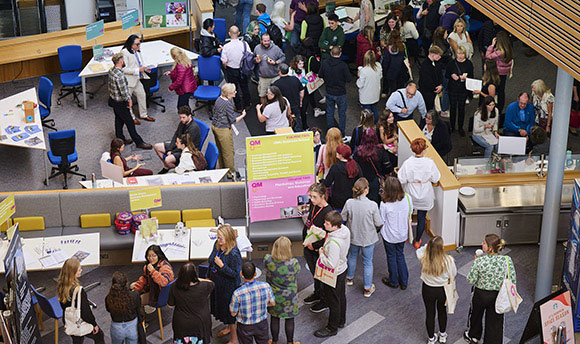Sustainability
Our holistic approach to sustainability
At Queen Margaret University, we have placed sustainability at the very core of our vision, taking a joined-up approach to the social, environmental and economic dimensions of sustainable development.
Our holistic approach not only takes account of our immediate campus environment and everyday behaviour but also extends to curriculum development and the impact of our teaching and research across the world.
Sustainability is embedded in the everyday work of the University, led by the Principal and senior leadership team, and delivered through an organisational structure where academics responsible for research and teaching take key decisions jointly with the team responsible for the physical environment.
Our campus, recognised as an exemplar in sustainability within the higher education sector nationally and internationally, is a physical example of our commitment to sustainability and is the foundation upon which our vision and strategy for sustainability continue to develop.
Situated on the east side of Edinburgh, by Musselburgh, our innovative campus set a new benchmark in sustainable design when it opened in 2007.
The building design maximises energy efficiency and the landscape design encourages biodiversity. Overall, the new campus building project is regarded as one of Scotland’s most sustainable – having gained a BREEAM* rating of “excellent” (the highest BREEAM score of any university in the UK).
The campus design is focussed on a simple low carbon, low energy passive design approach avoiding so called “green bling”. It has achieved the very highest sustainability awards and recognition without any impact on the cost of the build – one of the benefits of adopting an all round approach to going green.
A number of leading environmental technologies are being employed at the site including biomass heating, thin-client computer technology and a sustainable urban drainage system.
From the very outset, the new campus development was designed around modern agendas and technologies of higher education. We set out to “develop a sustainable community for learning and life”. The approach was to go beyond worthy statements that often fail to deliver, and to avoid sustainability gimmicks that often result in unnecessary building and maintenance costs.
When developing the campus, we called on an independent sustainability consultant (Gaia) to help us define the parameters of the sustainability project and to ensure that sustainability would be fully embraced throughout the design process. The design team were also selected on the basis of sustainability experience.
In developing the new campus, our approach to sustainability focused around:
• using resources effectively
• creating healthy environments
• promoting biodiversity
• managing the process
• supporting communities
• minimising pollution
Targets were set in achieving:
• a low carbon footprint
• biodiversity and a quality external environment
• indoor air quality and daylight
• green travel
Our approach to sustainability has resulted in strong performance statistics. When on campus, you can identify sustainability construction features by following the ‘sustainability trail’ signage.
BREEAM
QMU’s campus is regarded as one of Scotland’s most sustainable developments – the campus buildings, including the main academic building, the satellite sports and students’ union building and the residential accommodation buildings - have gained a BREEAM rating of “excellent” (with the highest score recorded of any university project). For over a decade, the Building Research Establishment's Environmental Assessment Method (BREEAM) has been used to assess the environmental performance of both new and existing buildings. It is regarded by the UK's construction and property sectors as the measure of best practice in environmental design and management.
Envest
Envest is a software tool that simplifies the process of designing buildings with low environmental impacts by providing an estimate of the impact of a design. The results from Envest are measured in ecopoints. An independent assessor undertook an assessment of the campus buildings using Envest (ENVironmentalESTimation) software and results demonstrated an exemplary environmental performance. Using units of ecopoints per unit of gross floor area we achieved 17 ecopoints/ m² compared with 22 ecopoints/ m² for the Building Research Establishment (BRE) environmental building category and 40 ecopoints/ for BRE’s published figure for a typical building.
Ceequal
Ceequal is the Civil Engineering Environmental Quality and Awards Scheme and measures a broad spectrum of engineering aspects of projects to be assessed. Ceequal assessment is carried out by a trained assessor and validated by external verifiers. The campus development has been awarded an excellent rating.
Awards
We have been recognised for our work in sustainability via the Green Apple Awards, the Green Gown Awards, Green Business Awards
Active Travel Awards
The University holds the status of cycling friendly employer and cycling friendly campus. The Cycling Friendly awards are awarded to universities and employers by Cycling Scotland in recognition of their clear commitment to increase the number of bike journeys made by students, staff and visitors. The university was awarded this status for its bike hire scheme and continuous efforts to promote and improve facilities on campus.
QMU was also awarded the Walk to Work award from Paths for All for our commitment and efforts to encourage walking to and on campus.
Energy efficiency
Energy use is minimised through intelligent design that incorporates air tightness, and maximises daylight and natural ventilation through the use of energy efficient technology including biomass heating, intelligent lighting and thin client computer technology. QMU’s targets for air tightness and u-values are a 25% and a 5% improvement respectively over minimum building regulation requirements.
Biomass heating
The campus' carbon emission - its carbon 'footprint' - is expected to be the lowest of any HE organisation in the UK through the use of a biomass heating system. Biomass is generally considered to be any kind of plant material, vegetation, or agricultural waste used as a fuel or energy source. On campus, a woodchip boiler generates heat for distribution around the campus, with a projected 75% reduction in carbon dioxide emission compared with traditional gas fired heating. The QMU biomass is the largest non-industrial installation of its kind in the UK.
Thin client computer technology
To minimise heat generation, and therefore reduce the need for ventilation, PC users on campus do not have hard disk drives at their desks. Instead, 'thin client' technology is used whereby software and hardware are stored at central servers. The energy consumption of the thin client terminals is significantly less than a traditional pc (at 34kwh/year compared with 320kwh/year for a pc).
Biodiversity
Biodiversity has been encouraged on campus through plans that included the creation of wetland, woodland, hedgerow and meadow habitats, and the provision of roosting boxes for indigenous wildlife. Special wildlife corridors mitigate potential conflict between wildlife and human traffic. Other provisions to add ecological values include plant selection to encourage invertebrate and bird populations, and replanting of hedgerows.
Sustainable urban drainage system (SUDS)
A SUDS pond is a key feature of the design, to capture rainwater draining off roofs and paved areas, holding it back on site rather than contributing to downstream flooding. As well as providing a solution to the problem of excess surface water, the pond is an attractive feature of the campus, and provides an excellent habitat for wildlife.
Water consumption
All of the water services (i.e. taps, sanitary fittings etc) have been designed to minimise water consumption.
Building energy management system (BEMS)
BEMS has been installed to optimise the operation of the heating, ventilation and lighting systems in the building.
Lighting controls
The lighting system within the building is intelligent. The further you sit from a window the brighter the lighting in that area becomes, and if you sit close to a window, the lighting dims to compensate. Interior lighting brightens as evening approaches. Lighting is managed via BEMS and turned on and off via a timer.
Indoor air quality and ventilation
The majority of the building is ventilated naturally. An exposed concrete slab at the top of the building absorbs the heat generated during the day and then cools at night allowing the building to maintain a consistent temperature. Benign paint and floor finishes have been used at the campus, minimising negative environmental impacts – for example, much of the flooring used is marmoleum, a natural product made from linseed oil, wood flour, rosin, jute and limestone.
Material selection
Over 80% of the materials within the campus come from renewable sources.
Adopting a more sustainable lifestyle
We have a green travel plan, actively promote green travel, and provide infrastructure to support this. Find out more about our Green Travel Plan and Strategy.
We have cheap bike rental on campus for staff and students directly through the university and also through JustEat Cycles. Electric and folding bikes are available to staff on request along with City Car Club cars. The university promotes car sharing with it’s own liftsharing group and has electric car club vehicles on campus with electric charging points available.
Allotments on campus encourage staff to grow their own produce.
QMU aspires to an holistic approach to sustainability. This is reflected in the remit and structure of our Sustainability Committee. Members represent all parts of the University, and the committee reports at a strategic level to the Executive Board.
The committee’s remit is wide, reflecting the broad relevance of the three pillars of sustainability. The committee will consider any matter falling under one or more of the pillars.
As well as its permanent members, the committee has power of co-option for relevant workstreams. It meets throughout the year, combining regular ‘business’ meetings with open plenary sessions based around guest speakers and topics.
Membership
School of Arts, Social Sciences and Management (2 persons)
School of Health Sciences (2)
University Secretary’s Group (2)
Campus & Commercial Services (1)
Human Resources (1)
Marketing & Communications (1)
Students’ Union (2)
Trade Unions (1)
*What is BREAAM
For over a decade, the Building Research Establishment's Environmental Assessment Method (BREEAM) has been used to assess the environmental performance of both new and existing buildings. It is regarded by the UK's construction and property sectors as the measure of best practice in environmental design and management.
Leadership
We recognise that outstanding leadership is crucial if we are to achieve lasting and widespread sustainability. We were an early signatory of the Universities and Colleges Climate Commitment for Scotland (UCCCFs) and have a five year Climate Change Action Plan which targets substantive improvement over all functions of the institution related to sustainability. We have a sustainability committee to drive and promote sustainability practice. There is explicit reference to sustainability in the University strategic plan. On campus, we host the Scottish office of the Environmental Association for University and Colleges (EAUC).
Learning
A number of degree programmes have been introduced at QMU that have a specific focus on sustainable practices, and others have developed modules on specific elements of sustainability, for example sustainable development and social justice. Our ambition is to create graduates that spread both sustainable practice and thinking as they progress throughout their careers and personal lives. We believe that QMU will be held as an exemplar in sustainability for years to come because of our view that the delivery of a low carbon campus was not an end in itself, but just the first step towards becoming a truly sustainable institution.



